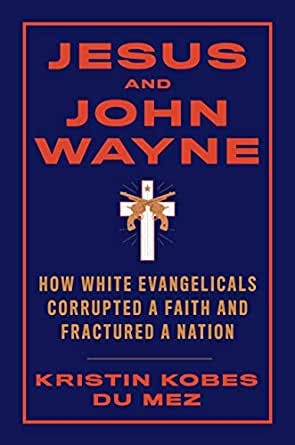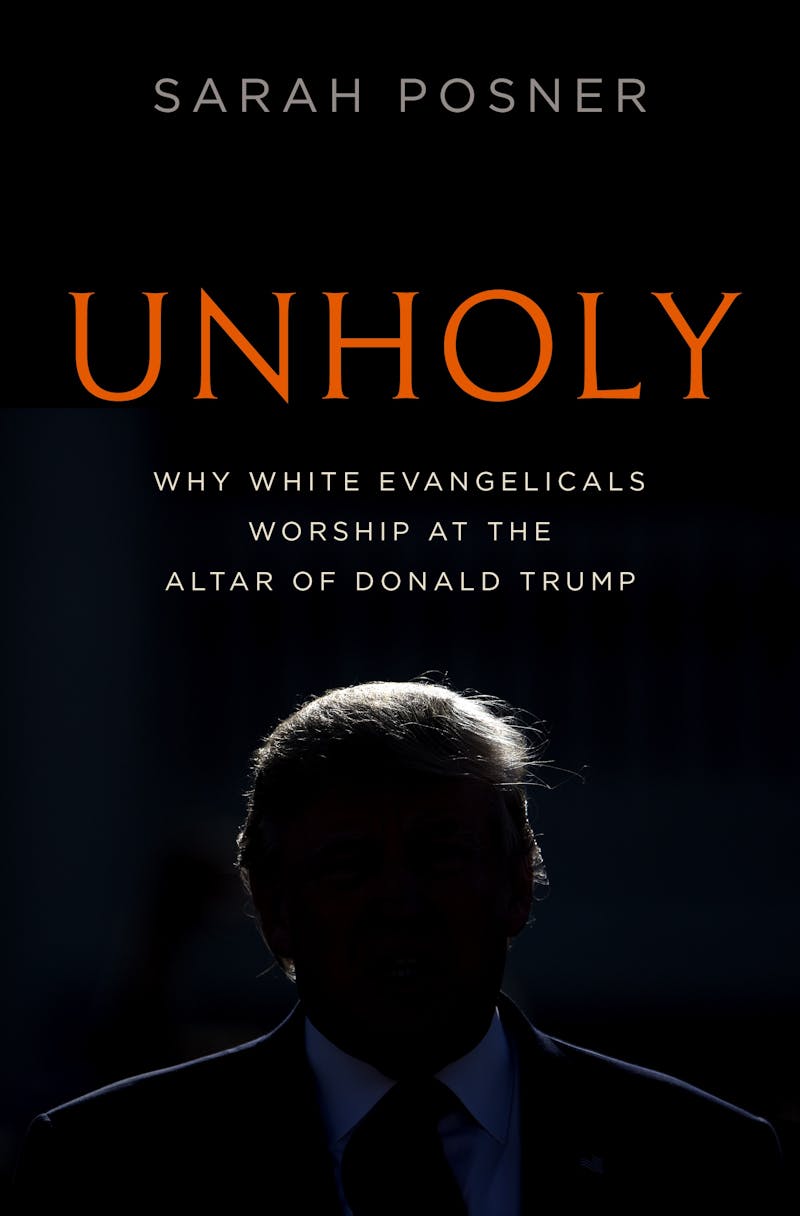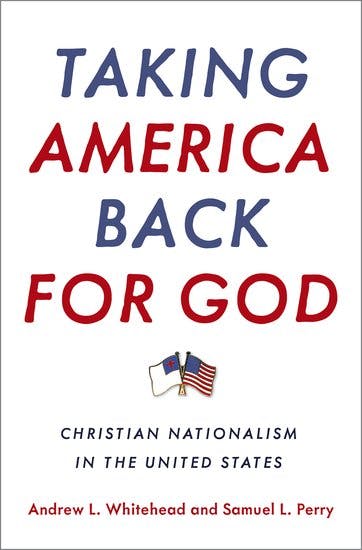

Donald Trump has never pretended to practice traditional Christian virtues. Yet in 2016 he earned 81 percent of the white evangelical vote—a higher percentage than George W. Bush, Mitt Romney, or John McCain. Trump’s success surprised a lot of us: How could a group of staunchly moral religious voters give their support to a man with a long track record of lying, cheating, using profanity, and grabbing women “by the pussy”?
If this seemed jarring, it may be because evangelical leaders have projected a whitewashed vision of their movement to the rest of the country so successfully for so long. To be an evangelical, leaders of the movement and the scholars who follow them insisted for several decades, is to commit to the authority of the Bible, the centrality of Jesus, the necessity of individual conversion, and evangelism. With this move, they separated evangelicalism from its existence in the world. Evangelicals might try to influence politics and culture, but politics and culture, they implied, had no impact on the untainted core of evangelicalism. Billy Graham might be sleeping in the Lincoln bedroom, and Jerry Falwell might be advising GOP platform committees, but the evangelical gospel was timeless, unaffected by the forces of history and the world around it. The sexists, racists, and xenophobes who regularly appeared in their ranks, they argued, did not reflect the true movement, only its distortions.
For the most part, this image of evangelicalism won the day. Historians and journalists swallowed the idea that evangelicalism was a system of theological beliefs independent from culture and politics. In the 2010s, a few scholars offered more accurate histories. But when it came time for elections, most Americans assumed that evangelicals would hold a presidential candidate to their own supposedly exacting standards of conduct.
Trump shattered those myths. As a presidential candidate, he masterfully stoked evangelicals’ terror of state power and brought their deep-seated racism and sexism to the surface. He demonstrated that fear, anger, and anxiety remained as central to the lives of evangelicals as any practices of forgiveness, love, understanding, or compassion. As three new books show, Trump connected with impulses that are central to the evangelical movement, from an insistence on patriarchy that Kristin Kobes Du Mez traces in Jesus and John Wayne, to the racism that Sarah Posner examines in Unholy, to the Christian nationalism that Andrew L. Whitehead and Samuel L. Perry study in Taking America Back for God.
For these authors, evangelicalism is about more than theological talking points. The Trump era has confirmed that we cannot separate evangelicalism from the racism, sexism, and xenophobia that gave rise to the movement over a century ago. What is more, the evidence has always been there for those willing to see it.

The modern evangelical movement was born in the late nineteenth century at a moment of tremendous turmoil. Americans were recovering from the horrors of the Civil War and the conflicts over Reconstruction, struggling through turbulent economic contractions, wrestling with the impact of massive immigration, and confronting novel ideas about the evolution of humans from monkeys. At that time a handful of white men crafted a new version of Christianity. Billy Sunday, whom Du Mez credits for championing a “muscular” style of Christianity, became their most popular spokesman.
Sunday gained fame in the 1880s as a gutsy base runner for the Chicago White Stockings. A few years later, he converted to evangelicalism and abandoned the ballpark for the revival tent. By the early twentieth century, his meetings filled the largest auditoriums in the country. His shows were raucous and entertaining. He had graduated, he boasted, “from the University of Poverty and Hard Knocks.” He paced as he preached, jumped around, waved his arms, and screamed at the devil. Although he claimed to be a common man from the “corn rows of Iowa,” he gained the backing of wealthy business leaders, including the Rockefellers. They loved how he blended theology, patriotism, and a defense of Gilded Age capitalism.
Sunday demanded that Americans make the United States a Christian nation, an effort that remains central to evangelicalism, as Whitehead and Perry illustrate. To Sunday and his followers, this meant reducing immigration, maintaining Jim Crow segregation, and pushing back against the women’s movement. “The black man is entitled to civic equality,” he acknowledged, but not “social equality,” and certainly not interracial marriage. He worried that foreigners with their strange religions were contaminating the country. “They call us the ‘melting pot,’” Sunday harangued. “Then it’s up to us to skim off the slag that won’t melt into Americanism and throw it into hell.” He also fought against a rising feminism. The future depended on teaching the “frizzle-headed, fudge-eating, ragtime flapper” to conform to Victorian gender roles.
In the 1930s, Sunday and his allies faced a new threat. The Roosevelt administration was expanding the power of the state and extending civil liberties to racial and ethnic minorities. Sunday fumed that if Americans allowed New Deal liberalism to flourish, “the rugged individualism of Americanism must go.” These changes convinced the evangelist that he was living in the end times and that the apocalypse was imminent. Jesus was coming back in judgment, and the United States would have to account for its actions.
If Billy Sunday were still the face of the evangelical movement, the results of the 2016 election might not seem so surprising. But in the wake of World War II, a new generation of leaders led by Billy Graham took charge of evangelicalism, and they distanced themselves from the overt bigotry of an earlier era. Aiming to grow their influence and power, they worked to make their movement more mainstream and respectable. They earned advanced degrees from prestigious universities, launched new centrist magazines, including Christianity Today, and opened academically rigorous seminaries for training ministers. Rather than take on civil rights legislation directly, they emphasized transforming hearts. Rather than treat women as inferior, they stressed that women were equal before God, just different in function. They encoded racism and sexism into their movement but made it appear more benign. They knew that in order to expand evangelicalism, they needed to muzzle the most extreme racists and nativists. They also kept up the fight against New Deal liberalism, linking faith with free-market capitalism.
For the next half-century, evangelicals claimed allegiance to a timeless, biblical morality, while battling to spread their ideas by penetrating the nation’s major centers of power—including politics, media, and education. Du Mez’s brilliant and engaging Jesus and John Wayne traces how evangelicals used their power to protect patriarchy over the last few generations. Trump’s victory, she writes, was “the culmination of evangelicals’ embrace of militant masculinity, an ideology that enshrines patriarchal authority and condones the callous display of power, at home and abroad.” By this account, the Jesus at the center of their lives is not the peacemaker of the gospels but a vengeful warrior Christ.
Across chapters ranging from “John Wayne Will Save Your Ass” to “Holy Balls,” Du Mez peppers her text with entertaining (and sometimes horrifying) examples. In 1973, Marabel Morgan published The Total Woman, giving Christians an alternative vision of womanhood to that trumpeted by Betty Friedan and the new feminism. Wives, she insisted, should be docile, submissive, and beautiful. The book inspired one Christian woman to greet her husband at the front door wearing only Saran Wrap. A few years later, evangelicals concerned about the sexual revolution began publishing their own P.G.-rated sex manuals. They all agreed that God wanted married Christians to have good sex, but they varied in their approach—some authors believed oral sex was acceptable, others thought it was always an abomination.
During this era, evangelicals cared little about abortion. Most believed that the use of birth control was appropriate within marriage, and early-term abortions were just another form of birth control. But as feminists made expanding reproductive rights a fundamental part of their agenda, evangelicals starting framing the procedure as “an assault on women’s God-given role, on the family, and on Christian America itself.” Seeking a president who would advocate for their understanding of gender roles, they rallied behind the divorced Ronald Reagan over the “masculinity challenged” Sunday School teacher Jimmy Carter. The former governor, who dressed like a cowboy, was “perfectly cast for his role as hero of the Religious Right.”
In the 1990s, evangelicals shifted from simply denouncing feminism to articulating a new vision of the ideal male. Promise Keepers, a ministry founded by college football coach Bill McCartney, organized male-only stadium rallies around the country. McCartney and his allies called for a renewal of Christian manhood defined by a “soft” patriarchy. They instructed men to reclaim authority in their families, express their feelings and emotions, love their wives, and invest in their children’s lives. Their rallies included lots of bro-hugs and tears, as well as a focus on individual racial reconciliation.
Promise Keepers did not last. The 9/11 terrorist attacks inspired another pivot among evangelicals. The “soft” patriarch ideal gave way to a resurrected militant warrior akin to Billy Sunday’s muscular Christian leaders. The faithful cheered George W. Bush, another cowboy president, as he launched a new, religiously tinged global crusade on behalf of a pro-war God. And after the Obama years, when pundits began talking about the end of white Christian America, evangelicals sought out another tough guy in Donald Trump. “For nearly fifty years,” Du Mez writes, “evangelicals were looking for a protector, an aggressive, heroic, manly man, someone who wasn’t restrained by political correctness or feminine virtues, someone who would break the rules for the right cause.” Trump satisfied their lust for a new prophet by vowing to lead them out of the secular wilderness. He became their ultimate fighting champion.
While Du Mez zeroes in on gender, journalist Posner focuses primarily on race. In her insightful book Unholy, Posner calls Trump “the strongman the Christian right had long been waiting for”—not just to affirm patriarchy but also to undermine 50 years of progress on civil rights. Evangelicals longed for a leader who “wasn’t afraid to attack, head-on, the legal, social, and cultural changes” that followed the civil rights movement.
The inspiration for evangelical partisan mobilization was school integration. Southern evangelicals such as Jerry Falwell criticized Martin Luther King Jr. during the 1960s, and hosted segregationists, including George Wallace, in their churches. But they believed they were safe from federal overreach until the 1970s, when the IRS began questioning the tax-exempt status of segregated Christian academies. Institutions that discriminated, the government argued, were by definition not “charitable.” The actions of federal agencies, supported by federal courts, encouraged the faithful to court new political partners.
Posner is only partially right here. When the IRS began
cracking down on whites-only schools, many Southern evangelicals took notice. But
this does not explain evangelical mobilization in the cities of the West and
North, where most evangelicals were already staunch Republicans and were not as
directly affected by desegregation. Evangelicals’ fear that the expansion of
state power signaled the end times and coming apocalypse—something Billy Sunday
and Billy Graham repeatedly predicted—preceded their concerns over integration;
some of the very same masterminds who founded leading religious right
organizations, such as Tim LaHaye, made millions of dollars peddling books
about diabolical end-times conspiracies. They believed that the federal
government and courts were their primary enemies. Evangelicals in the North and
West, many of whom opposed mandated segregation, fretted that if the government
could force Christian schools to admit African Americans, could it also force
them to offer ministerial training to women? Where would the government’s control
over their religious liberties end?
More than the other authors here, Whitehead and Perry still believe that evangelicalism can be redeemed and that the old theological definition still holds. They acknowledge the racism and sexism so prevalent in recent evangelicalism, but they have not lost hope. If only the 81 percent who voted for Trump understood the true faith, they imply in Taking America Back for God, evangelicals would repent of their Trump-loving ways.
They believe that the media and academics have conflated those who believe in Christian nationalism with those who believe in evangelicalism. The authors define Christian nationalism as “an ideology that idealizes and advocates a fusion of American civic life with a particular type of Christian identity and culture.” Christian nationalists believe that the U.S. was founded as an explicitly Christian nation; that the country’s success is in part a reflection of God’s ultimate plan for the world; that prayer should be allowed in public schools; and that the federal government should declare the U.S. a Christian nation, advocate Christian values, and support religious displays in public places.
The “Christianity” of Christian nationalism “includes assumptions of nativism, white supremacy, patriarchy, and heteronormativity, along with divine sanction for authoritarian control and militarism. It is as ethnic and political as it is religious.” Christian nationalists believe that their “heritage” is under attack, and they support strong policies against immigration, including a border wall. They claim that God has always set his chosen people apart. “Much of the Christian nationalist rhetoric born out of the Religious Right,” Whitehead and Perry write, “finds its roots in the desire to create boundaries of group membership around race and the right of white Americans to segregate themselves from minorities.” Trump’s promise to make America great again means “making their America again” by stopping the “Muslim terrorists” and “violent Mexican immigrants.”
Whether a person identifies as an evangelical is not the best predictor of how she will vote, the authors argue, and it does not indicate her views on hot button issues. The more religious a person was, the authors discovered, the less likely he or she was to support some of Trump’s core nationalist policies. Those who attend church the most, and pray and read their Bibles regularly, tend to be less enthusiastic about Trump’s positions on race, guns, immigration, and poverty. They are also less likely to fear atheists or immigrants from the Middle East. (This does not mean, however, that the most religious evangelicals are by any means liberal. The survey data reenforces Du Mez’s arguments that on questions of gender, sexuality, and the family, evangelicals and Christian nationalists align. The more committed a person is to his faith, the more committed he is to patriarchy.)
By contrast “Christian nationalism,” not evangelicalism, binds together Trump supporters on such issues as immigration, gun control, travel bans, refugees, political correctness, opioid addiction, public education, racial injustice in policing, “family values,” transgender rights, and secularism. Knowing a person’s position on Christian nationalism “can tell us far more” about their “social and political views” than knowing their denomination, record of church attendance, or even whether they identify as Democrat or Republican.
Yet Whitehead and Perry’s attempt to rehabilitate some portion of evangelicalism and separate it from Christian nationalism contains an element of wishful thinking. Since World War II, evangelicals have been Christian nationalism’s most enthusiastic promoters. Americans who attend white evangelical churches are far more likely to encounter Christian nationalism than those who do not. And so, while the authors make fine distinctions between the two groups, separating evangelicalism from Christian nationalism and its ugly historical legacies is not easily done in practice.
In 2018, Trump welcomed one hundred of the nation’s evangelical leaders to a dinner at the White House. The guest list included almost every one of the major leaders profiled by DuMez, Posner, and Whitehead and Perry. “We’re here,” the president explained to his audience, “to celebrate America’s heritage of faith, family, and freedom. As you know, in recent years, the government tried to undermine religious freedom. But the attacks on communities of faith are over. We’ve ended it. We’ve ended it.” Evangelicals finally had the kind of ally in the White House they had been longing for since the days of Billy Sunday. Trump aimed to bolster patriarchy, roll back the power of the courts, curtail immigration, and grant evangelicals a privileged position in the American religious landscape.
These three books help us understand how this happened. No
matter how many never-Trumper evangelicals argue that some kind of pure faith
exists independent of politics and culture, the truth is that evangelism and
Trumpism is a near-perfect partnership that grew out of a shared history and
culture.
Du Mez ends her book by calling on her readers to “dismantle” white evangelicalism by exposing its true history and priorities. But evangelicals will not be easily dispossessed of what they assume is rightfully theirs. God, they believe, has destined them to make the United States in their image. Trump’s success demonstrates that their power is still ascending. We can only hope that as the goals and tactics of Christian nationalism are exposed, the rest of us—secular and Christian, agnostic and “none”—will mobilize to bury it for good. If we don’t, then surely a different kind of apocalypse will soon be upon us.
